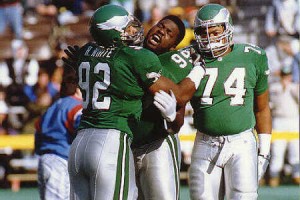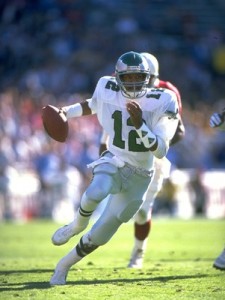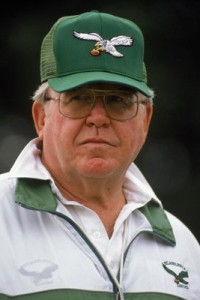Philadelphia Eagles 1988-1992: On the Edge of Greatness

Reggie White (#92), Jerome Brown (#99) and Mike Pitts (#74) were part of the dominating defense of the Eagles during the late 1980s.
A new NFL Network special looks back at a time 20 years ago when the Philadelphia Eagles also had a team that many believed had the talent to win a Super Bowl. However, while three of their division rivals were able to win titles in the early 1990s, the Eagles were left to contemplate what could have been.
The documentary focuses on two of the defensive stars from the Eagles teams of the late 1980s and early 1990s, Jerome Brown and Reggie White. Both players were key components of one of the dominant defenses of the era and both players passed away far too early (as did fellow Eagles from that era Todd Bell and Andre Waters).
Between 1988 and 1992, the Eagles posted a 52-28 regular season record and joined the San Francisco 49ers as the only teams in the NFL to post double digit victory totals in all five seasons. However, while the 49ers claimed two Super Bowl titles during that stretch and the other three were won by the Eagles’ NFC East rivals the Giants, Redskins and Cowboys, the Eagles were left waiting for a next year that never came.
Under the guidance of head coach Buddy Ryan, defense was the calling card of the Eagles during that era. Utilizing the 4-6 defense that had helped the Chicago Bears win a Super Bowl, Ryan turned the Eagles into an intimidating, ball-hawking defense that regularly created big plays on the defensive end of the game.
While the unit had many talented players, the unquestioned leader of the defense was defensive end Reggie White. The “Minister of Defense” was a defensive juggernaut and regularly punished any quarterback or running back that dared get in his way.
During his eight seasons with the Eagles between 1985 and 1992, White registered 124 sacks in 121 games, including an amazing 21 sacks in just 12 games during the strike-shortened 1987 campaign. He also forced 18 fumbles and recovered 12.
When Philadelphia made defensive tackle Jerome Brown their first pick (ninth overall) in the 1987 draft, it provided White with a rush partner that forced opposing offenses to worry about the rush from both the inside and outside.
By 1988, their third season under Ryan, the Eagles had gelled as a team and were ready to make a run at the playoffs.

In addition to having a cannon arm, Randall Cunningham led the Eagles in running four straight years.
After a slow start, they surprised many by winning six of their final seven games and claiming the NFC East title with a 10-6 record. Though the New York Giants also finished 10-6, the Eagles earned the division title and playoff appearance by sweeping the Giants. The second of those victories was a thrilling overtime contest when Clyde Simmons scooped up a blocked field goal and ran into the end zone for the win.
Though the Eagles lost in their opening playoff game in the infamous “Fog Bowl”, many believed that it was only a matter of time before the Eagles moved to the top of the NFC.
In addition to Brown and White, the Philadelphia defense of the era included another of other standouts including Clyde Simmons, Seth Joyner, Terry Hoage, Wes Hopkins, Andre Waters, Mike Reichenbach, Eric Allen, Al Harris, Mike Golic, Mike Pitts and Byron Evans.
The offense was spearheaded by dynamic quarterback Randall Cunningham. The athletic Cunningham was to the offense what White was to the defense, a rare talent and superstar player capable of changing the game with a big play at any moment.
What many point to as the fatal flaw for the Eagles was that the front office was never able to surround Cunningham with the weapons that could help catapult the offense to greatness. However, given the plethora of talented players who were part of the Philadelphia offense at various points during the era, it seemed to be more a matter of circumstances and scheme, rather than personnel that kept the Philadelphia offense from reaching championship form.
At various points between 1988 and 1992, Cunningham was throwing the ball to Mike Quick, Chris Carter, Carlos Carson, Keith Jackson, Jimmie Giles, Fred Barnett and Calvin Williams, all of whom caught at least 300 passes during their NFL careers.
Unfortunately, injuries and other circumstances kept Cunningham from fully utilizing the talents of these great receivers.
Quick, a five-time Pro Bowler, suffered a broken leg in the fifth week of the 1988 season and caught only 29 more NFL passes before retiring in 1990.
Carter had 89 catches and 19 touchdowns during three seasons with the Eagles, but off-the-field issues led Buddy Ryan to release him in 1990. Of course, Carter went on to become a Hall of Fame caliber receiver with the Minnesota Vikings and re-teamed with Cunningham for a magical campaign in 1998, but he showed only glimpses of brilliance while with the Eagles.
The running game was also a constant challenge for the Eagles during that era. Cunningham led the team in rushing for four straight seasons from 1987-1990, including 942 yards in 1990.

Buddy Ryan brought excitement and swagger to Philadelphia, but he was fired after losing in the playoffs for three straight years.
The Eagles posted an 11-5 record in 1989 and earned a home playoff game against the Los Angeles Rams. Despite many believing that they were the only team capable of defeating the defending Super Bowl Champion 49ers (the Eagles had led the 49ers 28-10 in the fourth quarter of their early season game before falling 38-28), the eagles played lethargic against the Rams and lost 21-7.
In 1990, the Eagles were 10-6 and again hosted a playoff game, but an anemic 20-6 loss to the Washington Redskins marked the third straight early playoff exit and the end of the Buddy Ryan era.
Any hopes of winning a title in 1991 went out the window in the opening game of the season when Cunningham suffered a season-ending knee injury on a rush up the middle (very similar play to what would end the season for Tom Brady in 2008).
But despite playing four different quarterbacks (Jim McMahon, Jeff Kemp, Matt Goebel and Pat Ryan) in Cunningham’s absence, the Eagles, under first year coach Rich Kotite, finished 10-6 and nearly made the playoffs.
The reason for this success was squarely due to a defensive unit that was at its peak. The 1991 Eagles allowed the fewest rushing, passing and total yards in the NFL and ranked fifth in points allowed. They registered 54 sacks (including nine by first team All-Pro Jerome Brown), intercepted 26 passes and recovered 37 fumbles.
With Cunningham returning for the 1992 season and running back Herschel Walker joining the fold to bolster the running game, optimism was high for the 1992 season until the tragic events of June 25, 1992.
With his 12-year-old nephew in the car, Brown lost control of his car and crashed into a power pole near his hometown of Brooksville, Florida.
The Eagles dedicated the 1992 season to Brown’s memory and played inspired football for much of the season. They won their first four games and final four games during an 11-5 season that culminated with a fourth playoff appearance in five seasons.
Playing on the road against the New Orleans Saints, the Eagles trailed 20-7 in the second half, but scored the final 29 points in a 36-20 victory. Fittingly, White accounted for two points when he tackled quarterback Bobby Hebert in the end zone and the final points scored on an interception returned for a touchdown by Eric Allen.
Unfortunately, the run to the Super Bowl ended the next week as the Eagles were no match for the eventual Super Bowl Champion Cowboys in a 34-10 loss.
The 1992 season proved to be the end of the window of opportunity for the Eagles. Reggie White left after the season as a free agent and eventually hoisted his Super Bowl trophy (along with former Eagle Keith Jackson) as a member of the Green Bay Packers.
Philadelphia started 4-0 in 1993, but Cunningham suffered a broken leg in the week four win over the New York Jets and the team lost seven of their next eight games before recovering to finish 8-8. The next season the Eagles lost several more standouts from their earlier teams and Kotite was fired after the team lost their final seven games to finish 7-9.
For many long-time fans of the Eagles the era between 1988 and 1992 is one remembered fondly for the bravado, excitement and entertainment that was provided by a cast of characters that was fun to watch and brought an energy to the city at a time when the other professional sports teams in Philadelphia were struggling.
However, there is also that sense for anyone who saw the Eagles play during that era that they missed out on something special. For whatever reason, this team with enough talent to win a Super Bowl was never able to take the final steps to a title and left the city an unfulfilled taste.
Of course, that feeling has continued for the past two decades as Philadelphia has made the playoffs nine times since 2000, but have reached the Super Bowl only once and lost to the Patriots in Super Bowl XXXIX.
While the Eagles of the Buddy Ryan era were built primarily through the draft and signing of young free agents, the team has chosen a different approach to try and change their history in 2011. The current Eagles have been self-dubbed the “Dream Team”, but they better hope that they are actually the “Reality Team” as Philadelphia has had dream teams in the past and know all too well that dreams fade.
Such was the case for the Eagles from 1988-1992 as they captured the hearts of the city, but never captured the championship that would have cemented their place in NFL history.
Dean Hybl served as an intern in the Public Relations Office of the Eagles for the 1989 season.
enjoy your things end for end it Philadelphia Eagles 1988-1992: Put the Opening or close of Eminence | Sports Soon afterward and
Growing up in Philly, I have fond memories of those Eagles teams. A lot of the same stuff can be said about the early 2000s Eagles. Front Office didn't get enough help for McNabb, etc. Good Read
http://www.ridethepine.com
I feel that is one of the most important info for me. And i’m glad reading your article. However wanna observation on some common issues, The site style is wonderful, the articles is truly nice : D. Excellent job, cheers
Hello colleagues, good article and pleasant urging commented here, I am truly
enjoying by these.
Good response in rsturn of this issue witrh solid arguments and telling the
whole thing concernong that.